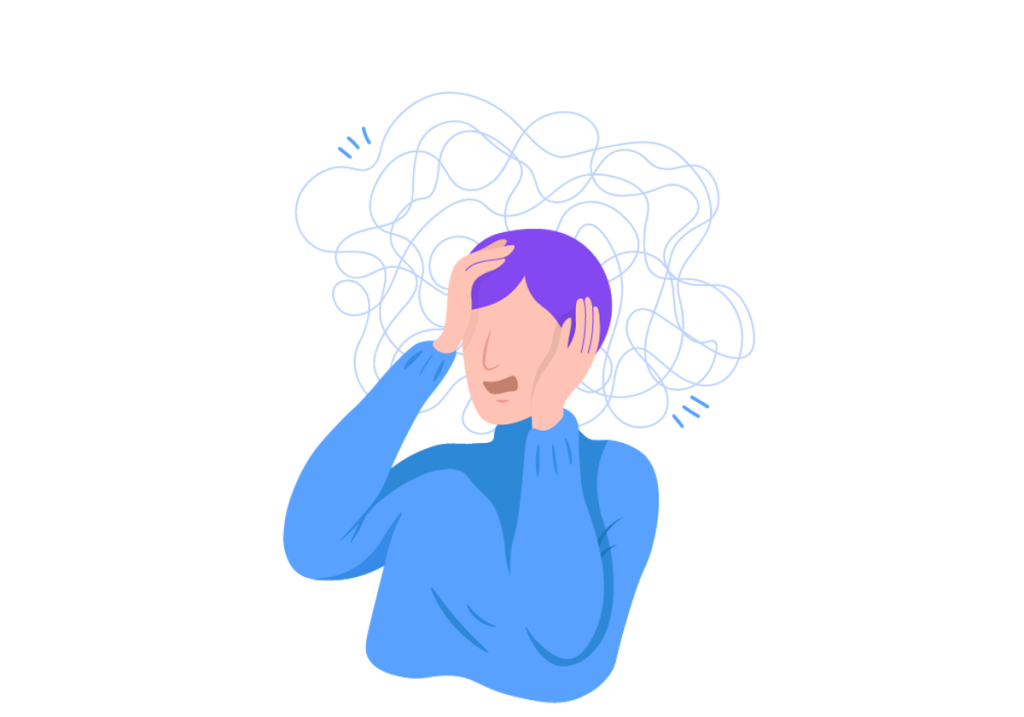Do you sometimes feel like you’re about to have a heart attack? Do you feel like you can’t breathe, and that your chest is tight? If so, you may be experiencing a panic attack. Panic attacks are a relatively common problem, and there are many different ways to treat them. In this article, we will discuss the symptoms, risk factors, and treatment options for panic attacks. We will also hear from experts about their views on this condition.
Contents
Understanding Panic Attack
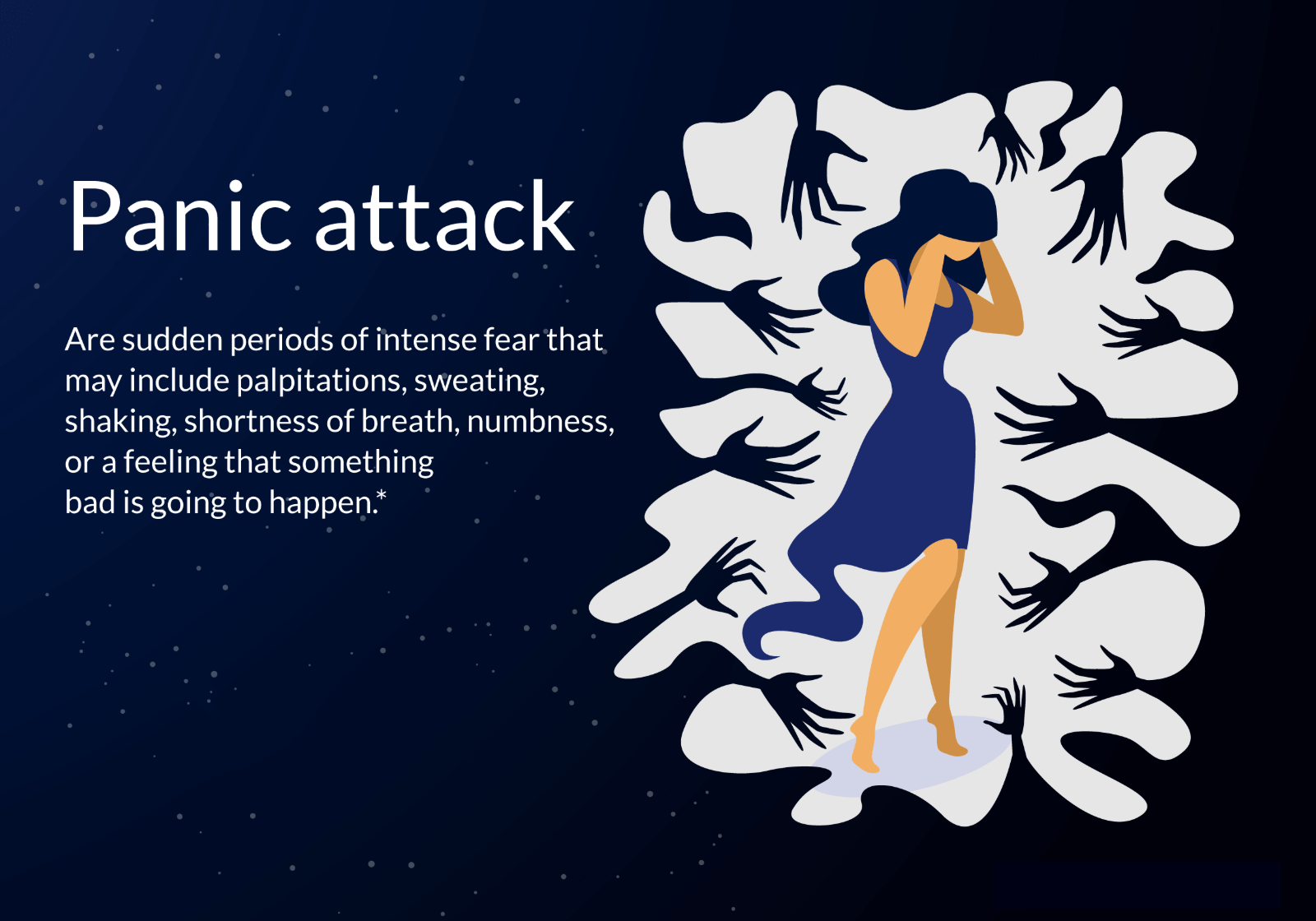
A panic attack is a sudden and intense feeling of fear or anxiety. It can last for just a few minutes, or it may persist for several hours. Some people have one panic attack per year, while others may experience them multiple times per week.
Degrees Of Panic Attack
There are three degrees of a panic attack:
Mild: These attacks cause a mild feeling of fear or anxiety. They may last for a few minutes, and there are usually no physical symptoms.
Moderate: These attacks cause a moderate level of fear or anxiety, and they may persist for up to an hour. Physical symptoms such as chest pain, shortness of breath, and dizziness are common.
Severe: These attacks cause a great deal of fear or anxiety, and they may persist for several hours. Physical symptoms such as chest pain, shortness of breath, and dizziness are very common.
Signs And Symptoms Of Panic Attack
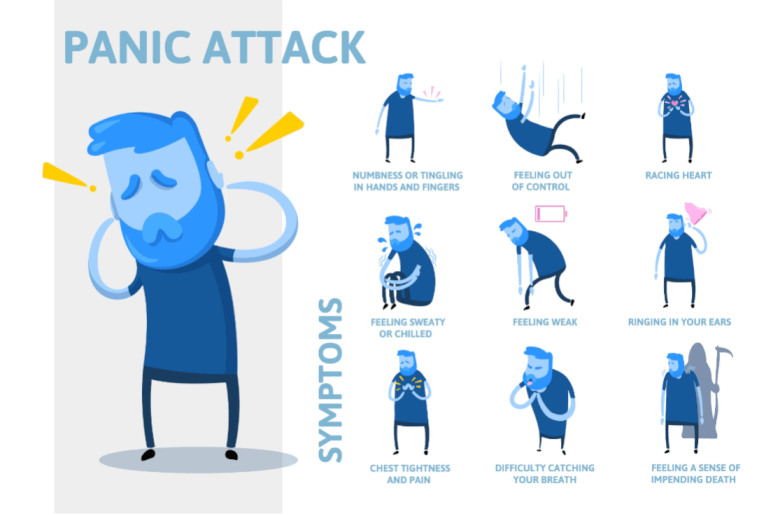
The signs and symptoms of a panic attack vary from person to person. However, some of the most common symptoms include:
Racing heart: This is often accompanied by a feeling of chest pain or tightness.
Shortness of breath: This may be accompanied by a feeling of dizziness or lightheadedness.
Sweating: You may sweat profusely, even if the room is cool.
Feeling faint: Many people feel like they are about to pass out during a panic attack.
Nausea: You may feel sick to your stomach or have an upset stomach.
Tremors: Many people experience trembling or shaking during a panic attack.
Dizziness: You may feel dizzy, unsteady, or like you are about to fall.
Chills: You may have a feeling of coldness or shivering.
Hot flashes: You may experience a sudden rush of heat.
DSM On Panic Attack
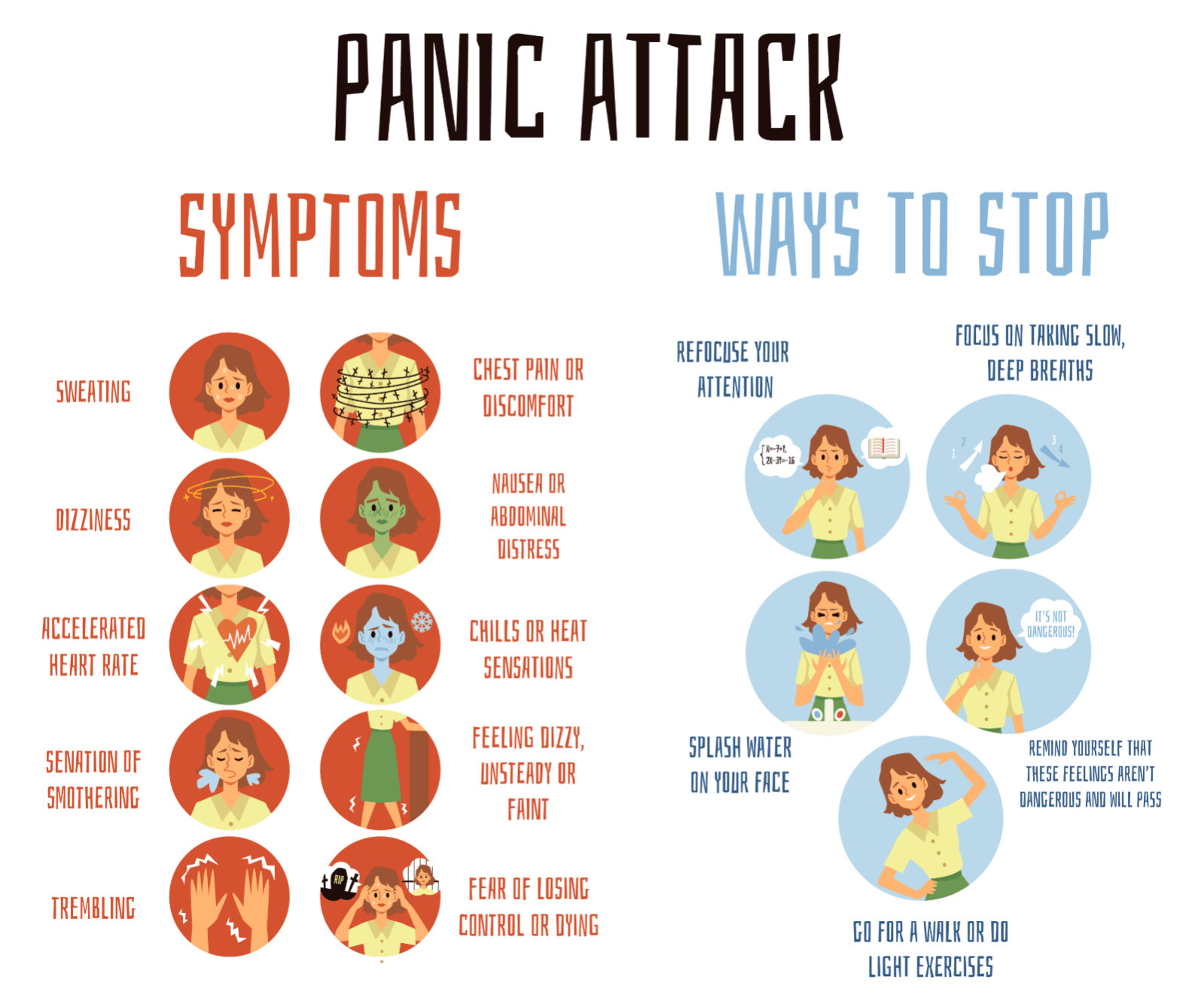
The Diagnostic and Statistical Manual of Mental Disorders (DSM) is the standard classification of mental disorders used by mental health professionals in the United States.
According to the DSM, a panic attack is “a discrete period of intense fear or discomfort, in which four (or more) of the following symptoms develop abruptly and reach a peak within minutes:
- palpitations, pounding heart, or accelerated heart rate
- sweating
- trembling or shaking
- sensations of shortness of breath or smothering
- feeling of choking
- chest pain or discomfort
- nausea or abdominal distress
- feeling dizzy, unsteady, lightheaded, or faint
- derealization (feelings of unreality) or depersonalization (being detached from oneself)
- fear of losing control or going crazy
- fear of dying.”
Types Of Panic Attack
There are several different types of a panic attacks:
Agoraphobia-related panic attacks: These attacks occur when you are in a situation that you fear or feel uncomfortable in. For example, you may have a panic attack when you are driving on the highway, or when you are at a party.
Situation-dependent panic attacks: These attacks happen only in certain situations. For example, you may only experience panic attacks when you are driving, or when you are in a crowded place.
Panic attacks without a known cause: These panic attacks may occur for no apparent reason. You may suddenly experience intense fear or anxiety for no discernible reason.
Risk Factors Of Panic Attack
Several risk factors can increase your chances of having a panic attack. These include:
Having a history of anxiety or panic attacks: If you have had a panic attack in the past, you are more likely to experience another one.
Having a family history of anxiety or panic attacks: If your parents or siblings have experienced panic attacks, you are more likely to experience them as well.
Stressful life events: Experiencing a traumatic event, such as the death of a loved one, can increase your risk of having a panic attack.
Smoking: Cigarette smoking can increase your risk of experiencing a panic attack.
Drinking alcohol: Drinking alcohol can also increase your risk of having a panic attack.
Having a mental health condition: If you have a mental health condition, your risk of experiencing a panic attack is increased. Such as depression or bipolar disorder.
Comparing Panic Attack With Panic Disorder
Panic disorder is a mental health condition that is characterized by recurring panic attacks. A panic attack is an intense feeling of fear or anxiety that lasts for a few minutes or hours.
There are several key differences between panic attacks and panic disorder:
Duration: A panic attack typically lasts for just a few minutes, while a panic disorder can last for months or years.
Frequency: A person with panic disorder may experience multiple panic attacks per day, while a person with panic attacks typically only experiences them occasionally.
Cause: A panic attack can be caused by any number of factors, while a panic disorder is typically caused by irrational fears and worries.
Impact on daily life: A person with a panic disorder often has trouble functioning in everyday life, while a person with panic attacks may only experience minor disruptions.
Treatment: A person with the panic disorder typically requires treatment from a professional, while a person with panic attacks can often treat themself through self-help methods.
Living With Panic Attack
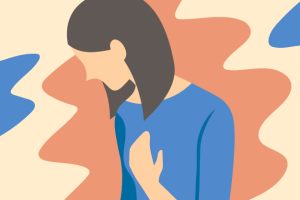
There are several challenges that people with panic attacks face daily:
Feeling isolated and alone: People with panic attacks often feel like they are the only ones who have to deal with this type of fear and anxiety.
Having to constantly worry about an attack happening: People with panic attacks often spend a lot of time worrying about when the next attack will happen and what it will be like.
Feeling embarrassed or ashamed: Many people with panic attacks feel embarrassed or ashamed about the way they are feeling, which can lead to isolation.
Impact Of Panic Attacks On Relationships
People with panic attacks can often have difficulty maintaining healthy relationships. This is because the person with panic attacks may:
- be too anxious to socialize.
- avoid any situation that they fear could trigger an attack.
- feel like they are a burden on their partner or friends.
As a result, people with panic attacks can often experience tension and conflict in their relationships. This is because the person with panic attacks may feel like they are a burden to their loved ones. Or that their loved ones don’t understand what they are going through.
Impact Of Panic Attacks On Work
People with panic attacks can also experience difficulty at work. This is because:
- the person may be too anxious to concentrate on their work.
- they may avoid any situation that could trigger an attack.
- they may feel like they are a burden on their colleagues or boss.
As a result, people with panic attacks can often have trouble keeping their jobs.
Coping With Panic Attack
There are several things that people with panic attacks can do to help themselves:
Educate yourself about panic attacks: The more you know about what a panic attack is and what causes it, the better equipped you will be to deal with it.
Talk to someone who understands: Talking to someone who understands what you are going through can be very helpful. This may be a friend, family member, or therapist.
Practice relaxation techniques: Relaxation techniques such as yoga or meditation can help to calm the mind and body during a panic attack.
Avoid alcohol and caffeine: Alcohol and caffeine can aggravate feelings of anxiety and fear.
Avoid any situation that could trigger an attack: If there is something that you know triggers your panic attacks, try to avoid it.
Self-help Tips
If you are having a panic attack, the following tips may help to calm yourself:
Remind yourself that the attack will eventually end: This is not a permanent condition and it will eventually go away.
Focus on your breathing: Slow, deep breaths can help to calm the body and mind.
Try to stay positive: It’s important to remember that panic attacks are not dangerous and you will get through this.
Distract yourself: If you can distract yourself from the fear and anxiety, it may help to lessen the attack. Focus on something calming, such as the nature of your breathing.
Talking To a Professional
If you are experiencing panic attacks regularly, it is important to seek professional help. This is because a professional can:
Help to identify the cause of your panic attacks: This can help to get rid of any fears or anxieties that may be triggering the attacks.
Guide how to cope with panic attacks: This can be very helpful in managing your attacks.
Suggest medication: If needed, a professional may prescribe medication to help control your panic attacks.
Treatment Options
If you are struggling with panic attacks, there are several treatment options available:
Self-help: There are also several self-help options available for people with panic attacks. This includes books, websites, or support groups.
Therapy: Therapy is a type of treatment that involves talking to a therapist about your fears and anxieties. This can be very helpful in managing panic attacks.
Medication: Certain medications can help to reduce the frequency and severity of panic attacks. For example antidepressants, benzodiazepines, and beta-blockers.
Self-help groups: There are self-help groups available for people who experience panic attacks. This can be a great way to connect with others who understand what you are going through.
Therapies For Treating Panic Attack
There are a few different therapies that can be used to treat panic attacks:
Cognitive-behavioral therapy (CBT): CBT is a type of therapy that helps you to change the way you think and behave. This can help to reduce feelings of anxiety and fear.
Interpersonal psychotherapy (IPT): IPT is a type of therapy that focuses on your relationships with others. This can help to identify any problems that may be triggering your panic attacks.
Psychodynamic therapy: Psychodynamic therapy is a type of therapy that focuses on your past. This can help to identify any unresolved issues that may be causing your panic attacks.
Exposure therapy: Exposure therapy is a type of therapy that involves gradually exposing you to the things that scare you. This can help to reduce feelings of fear and anxiety.
Medication for Panic Attack
There are a few different types of medication that can be used to treat panic attacks:
Antidepressants: Antidepressants are medications that can help to reduce the symptoms of anxiety and depression.
Benzodiazepines: Benzodiazepines are medications that can help to calm the mind and body. They are often used to treat anxiety disorders.
Beta-blockers: Beta-blockers are medications that can help to control the physical symptoms of a panic attack. This includes a racing heart, sweating, and shaking.
NOTE: It is important to speak with your doctor before starting any medication for panic attacks. They will be able to recommend the best medication for you.
Helping Someone With Panic Attack
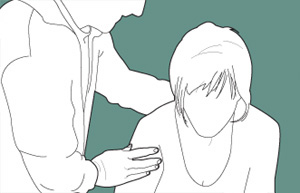
If you know someone who is struggling with panic attacks, there are a few things that you can do to help:
Listen and be supportive: It’s important to listen to what the person is saying and offer your support.
Don’t judge them: It’s important not to judge the person for their feelings or symptoms.
Encourage them to seek help: It’s important to encourage the person to seek professional help.
Offer practical assistance: If possible, offer the person practical assistance such as driving them to appointments or helping them with groceries.
Provide support during a panic attack: If the person is having a panic attack, it’s important to stay calm and supportive.
Educate yourself: Educate yourself about panic attacks so that you can better understand what your friend is going through.
Helping Someone Having a Panic Attack
When someone is having a panic attack, it is important to:
Remain calm: Panicking will only make the situation worse.
Reassure them: Let them know that they are safe and that the attack will eventually end.
Avoid judgment: Do not judge them or their actions during the attack.
Provide support: Stay with them until the attack has ended.
NOTE: If the person is having a panic attack for the first time, it is important to get them to a hospital or emergency room.
Experts’ View On Panic Attack
There is no one “expert” view on panic attacks. However, most experts agree that:
Panic attacks are not dangerous: Panic attacks are not harmful and will not cause any long-term damage.
They are treatable: Panic attacks can be treated with a combination of self-help measures, therapy, and medication.
Panic attacks are caused by a combination of factors: There is no single cause for panic attacks. They are the result of a combination of genetic, environmental, and psychological factors.
Case Study
In this case study, we will explore the story of Sarah*, a woman who experiences panic attacks.
Sarah first started experiencing panic attacks when she was in college. She would often feel an intense sense of fear and dread, followed by a range of physical symptoms, including chest pain, shortness of breath, and dizziness.
These attacks would often occur out of the blue and without warning. Sarah found them very frightening and was not sure how to cope with them.
She eventually went to see her doctor, who diagnosed her with panic disorder. He recommended that she try a combination of medication and therapy.
After a few months of treatment, Sarah found that her attacks had become much less frequent. She was now able to manage them more effectively and no longer felt as afraid or panicked.
NOTE: The name has been changed to protect privacy.
Resources For Panic Attacks
There are a few resources available for people who are struggling with panic attacks:
Books: There are several books available on panic attacks. This can be a great way to learn more about the condition. Example: “Don’t Panic: Taking Control of Anxiety Attacks” by David D. Burns
Websites: There are several websites available that offer information and support for people with panic attacks.
Support groups: There are often support groups available for people who are struggling with panic attacks. This can be a great way to connect with other people who understand what you are going through.
Conclusion
In conclusion, panic attacks are a very common and distressing condition. However, they can be treated successfully with a combination of self-help measures, therapy, and medication. If you are experiencing panic attacks, it is important to speak with your doctor for help.
A Word From Therapy Mantra
Your mental health — Your psychological, emotional, and social well-being — has an impact on every aspect of your life. Positive mental health essentially allows you to effectively deal with life’s everyday challenges.
At TherapyMantra, we have a team of therapists who provide affordable online therapy to assist you with issues such as depression, anxiety, stress, workplace Issues, addiction, relationship, OCD, LGBTQ, and PTSD. You can book a free therapy or download our free Android or iOS app.
